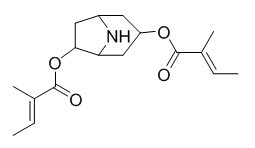3,6-Ditigloyloxynortropane
Standard reference
Inquire / Order:
manager@chemfaces.com
Technical Inquiries:
service@chemfaces.com
Tel:
+86-27-84237783
Fax:
+86-27-84254680
Address:
1 Building, No. 83, CheCheng Rd., Wuhan Economic and Technological Development Zone, Wuhan, Hubei 430056, PRC
Providing storage is as stated on the product vial and the vial is kept tightly sealed, the product can be stored for up to
24 months(2-8C).
Wherever possible, you should prepare and use solutions on the same day. However, if you need to make up stock solutions in advance, we recommend that you store the solution as aliquots in tightly sealed vials at -20C. Generally, these will be useable for up to two weeks. Before use, and prior to opening the vial we recommend that you allow your product to equilibrate to room temperature for at least 1 hour.
Need more advice on solubility, usage and handling? Please email to: service@chemfaces.com
The packaging of the product may have turned upside down during transportation, resulting in the natural compounds adhering to the neck or cap of the vial. take the vial out of its packaging and gently shake to let the compounds fall to the bottom of the vial. for liquid products, centrifuge at 200-500 RPM to gather the liquid at the bottom of the vial. try to avoid loss or contamination during handling.
Front Pharmacol.2021, 12:690113.
Cell Commun Signal.2024, 22(1):597.
Nutrients.2017, 10(1)
Theranostics.2023, 13(9):3103-3116.
Exp Ther Med.2019, 18(6):4388-4396
Heliyon.2023, 9(11):e21944.
Int J Mol Sci.2020, 21(8):2790.
Front Nutr.2021, 8: 687851.
Arch Biochem Biophys.2020, 687:108363.
Appl. Sci. 2021, 11(22), 10552
Related and Featured Products
Biochem Syst Ecol. 2001 Aug;29(8):819-825.
Alkaloids of Erythroxylum (Erythroxylaceae) species from Southern Brazil.[Pubmed:
11412954]
METHODS AND RESULTS:
A new alkaloid identified as 3beta,6beta-ditigloyloxynortropane(3,6-Ditigloyloxynortropane) as 3beta,7beta-ditigloyloxynortropane, 4-hydroxyhygrinic acid, methylecgonidine and tropacocaine have been isolated from the leaves of Erythroxylum argentinum. The new structure was established by means of spectroscopic techniques. Four other species E. deciduum, E. microphyllum, E. pelleterianum and E. cuneifolium collected in the state of Rio Grande do Sul were screened for methylecgonidine and tropacocaine by CG/MS.
CONCLUSIONS:
Two of these plants contain tropacocaine and two contain methylecgonidine. GC/MS analysis of all 5 species for cocaine proved fruitless. The chemotaxonomic significance of these results is discussed.



